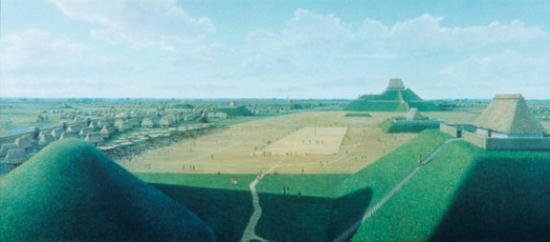Owen Jarus
Source - http://www.livescience.com/22737-cahokia.html
Cahokia was a city that, at its peak from 1050-1200 A.D., was larger than many European cities, including London. The city encompassed at least 120 mounds and a population between 10,000 and 20,000 people spread out over six square miles (16 square kilometers).
Located across the Mississippi River from modern-day St. Louis, it was the largest pre-Columbian city north of Mexico. The inhabitants of Cahokia did not use a writing system, and researchers today rely heavily on archaeology to interpret it.

The pre-Columbian settlement at Cahokia was the largest city in North America north of Mexico, with as many as 20,000 people living there at its peak.
CREDIT: Painting by Lloyd K. Townsend. Courtesy of the Cahokia Mounds State Historic Site, Illinois.
Cultural finds from the city include evidence of a popular game called “Chunkey” and a caffeine loaded drink. Artistic finds include stone tablets carved with images (such as a birdman) as well as evidence of sophisticated copper working, including jewelry and headdresses.
The city fell into decline after 1200 A.D., becoming abandoned by 1400. The name “Cahokia” is from an aboriginal people that lived in the area during the 17th century.
Much of the city lies buried under 19th- and 20th-century developments, including a highway and the growth of the city of St. Louis. Over the past few decades, efforts have been made to preserve what remains, with Cahokia’s core now part of a state historic site.
Monks Mound
The most awesome example of architecture at Cahokia is the 100-foot (30-meter) tall “Monks Mound” — the name given to it because a group of Trappist monks lived near it in historic times.
It was built with four terraces, covering about 17 acres (6.8 hectares) at its base, the mound towering over the city. Archaeologists have found giant postholes at the top indicating the presence of what may have been a temple, presumably made of wood, measuring 104 feet (31 meters) by 48 feet (15 meters). Its postholes are over 3 feet (1 meter) in diameter, the building being perhaps 50 feet (15 meters) tall.
Monks Mound, along with a grand plaza and a group of smaller mounds, was walled in with a 2-mile-long (3.2 km) wooden palisade. As many as 20,000 wooden posts were used to construct it.
Woodhenge
To the west of Monks Mound is a series of five circles, each originally made of red cedar wood posts, constructed at different times between 900 and 1100 A.D. They vary in size from 12 to 60 posts, the latest one being the smallest. Archaeologists refer to these structures as a “woodhenge,” a reconstruction of which now exists.
These posts would likely have been used as a calendar of sorts marking the solstices, equinoxes and festivals important to the inhabitants. A priest could have stood on a raised platform in the middle.
The sunrise during the equinox, when it rises to the east, is said to be particularly spectacular from this spot. A post aligns with the front of Monks Mound and the massive structure looks like it “gives birth” to the sun, according to a modern account recorded on the Cahokia Mounds state historic site website.
Human sacrifice
Mound 72 is a 10-foot (3-meter) high structure located less than a half-mile south of Monks Mound. It dates between 1050 and 1150 and holds the remains of 272 people, many of them sacrificed — the largest number of sacrificial victims ever found north of Mexico.
The mound’s archaeology is complicated but several instances of human sacrifice can be made out. In one case 39 men and women were executed “on the spot,” writes archaeologist Timothy Pauketat in his book Cahokia: Ancient America’s Great City on the Mississippi. “It seemed likely the victims had been lined up on the edge of the pit... and clubbed one by one so that their bodies fell sequentially into it.”
In another episode of sacrifice, 52 malnourished women between the ages of 18 and 23 appear to have been sacrificed at the same time, along with a woman in her 30s. In another burial episode, 15 corpses, a mix of men, women and children, were found on wooden stretchers.
Curiously, this burial mound also has the remains of two men who were found buried with 20,000 shell beads, likely the remains of a garment(s). Analysis of their remains indicates that they consumed a large amount of meat, suggesting that they were elite members of Cahokia’s society, the human sacrifices at the mound possibly dedicated to them in some way.
Chunkey
Cahokia supported a rich variety of art and cultural activities. Among them are stones used for a once wildly popular game called “Chunkey.”
Archaeologists cannot be certain what the exact rules were at the time Cahokia thrived. Accounts of the game in the 18th and 19th century tell of a stone disc, called a “chunkey stone,” that would be rolled on a playing field with people throwing giant sticks, larger than themselves, at it, trying to land them as close to the stone as possible. Points would be given depending on how close they came. Gambling on the outcome of this game was common, according to writers.
Pauketat envisions Chunkey being played as a team sport at Cahokia in the plaza beside Monks Mound. In an Archaeology Magazine article he writes that “the chief standing at the summit of the black, packed-earth pyramid raises his arms. In the grand plaza below, a deafening shout erupts from 1,000 gathered souls. Then the crowd divides in two, and both groups run across the plaza, shrieking wildly. Hundreds of spears fly through the air toward a small rolling stone disk...” Spectators would cheer them on, witnessing a great sport that captivated the North American city.